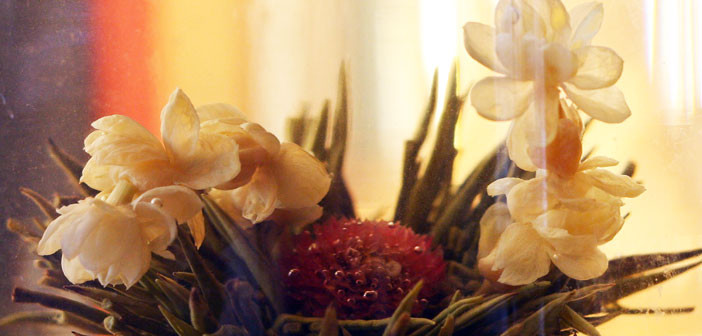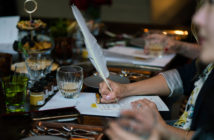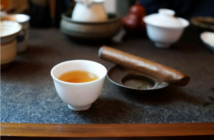note that this article was previously published on August 19th, 2014
Looking for a beautiful gift idea or a tea for your next special occasion? Blooming teas are both a visual and culinary delight! There are several variations of blooming teas, which begin with a base of green, black or oolong tea. The tea leaves and flowers are sorted and weighed to create consistently sized rosettes. Some bundles are made by the trained artisans stitching together tea leaves or tea buds with cotton thread, others are made adding edible flowers.
Adding complexity to the aroma and enhancing tea color, the flowers used may include jasmine, tiger lily (Lilium lancifolium), globe amaranth (Gomphrena globosa), chrysanthemum (Chrysanthemum spp), hibiscus (Hibiscus L.) and osmanthus (Osmanthus fragrans). Finished teas are often green or yellow, with a mild flavor and a touch of sweetness.
Flowers are carefully dehydrated prior to their assembly. Artisans take anywhere from one minute to thirty to create one blooming tea. Once assembled, the teas are dried and fired, similar to the process used to create other types of tea. The stitching technique of the artisan influences the final shape of each blossom. Extra space is left between the various components of the tea bud, leaving room for hot air which helps open up the bud.
When brewed, the heat of the water inflates the flower so it expands as it steeps. A glass teapot serves as the ideal container, allowing you to watch the show as the tea blossom, often revealing a flower as the centerpiece. A large white teapot is a nice alternative if you don’t have a glass one. Watching the bud “bloom” creates a relaxing experience that should be savored.
Blooming teas became readily available in the 1980s; however, there are stories that this art has ancient origins. One theory is that the teas were developed during the Song dynasty for the emperor. This lovely style of tea is also mentioned throughout Chinese literature. Old folk stories and poetry inspire elaborate designs.
Whatever the theories, these teas were most recently created in the Yunnan province of China, but this would make an excellent do it yourself project by adapting the type of flowers included, and picking things such as American elderberry (Sambucus canadensis), English marigold, (Calendula officinalis), anise hyssop (Agastache foeniculum) or Black locust (Robinia pseudoacacia) [note: use only its flowers]. A more savory concoction could be created with flowers from herbs such as basil (Ocimum basilicum), or chicory (Cichorium intybus).
Flowering teas are designed to provide several servings, so they make a great choice for a tea party, book club, or intimate family gathering. You can find blooming teas at local specialty tea shops.
If you are interested in purchasing online, find a reputable tea company, since there are instances of the inferior blooming teas being created just for show, rather than having both exquisite visuals and superb flavors. The teas are packaged individually, so they remain intact during shipping.
If you are looking for a taste of luxury, the blooming tea will be a unique treat!
Photo courtesy of Janis Marshall.




